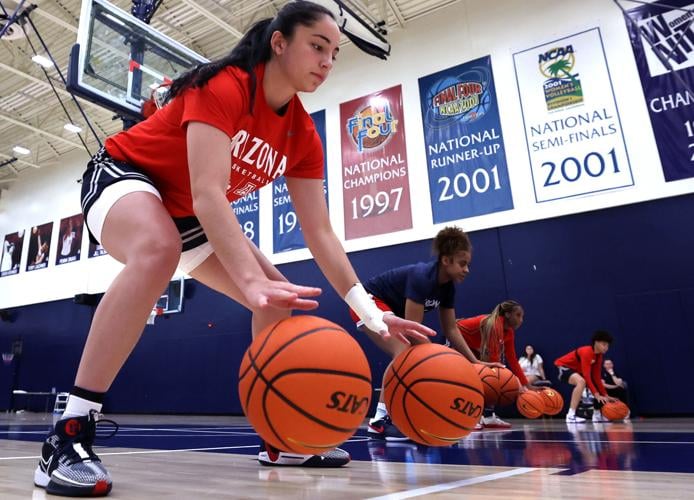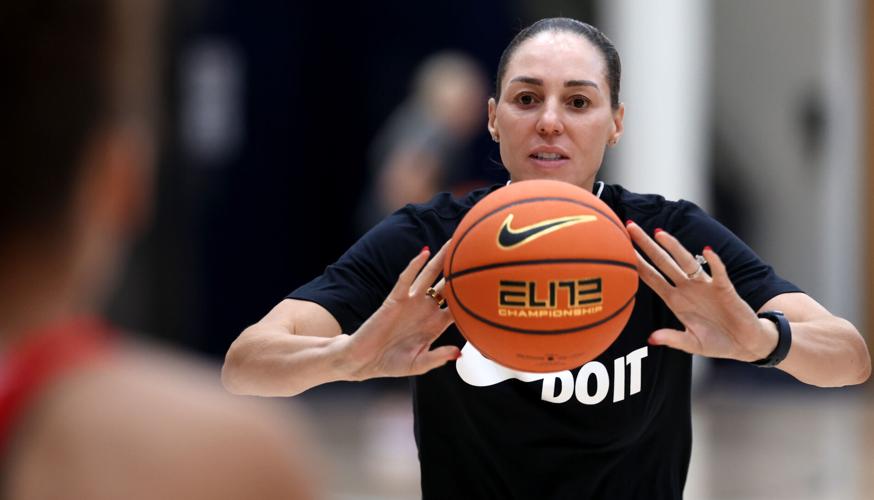When it comes to women’s college basketball, one of the not-so-little secrets concerns how much money top-level athletes are getting, specifically from independent collectives that support a university’s athletic cause, in the form of marketing the athlete’s name, image and likeness.
Just like men’s basketball and football, some of these payouts are life-changing — six figures and climbing.
Arizona women’s basketball coach Adia Barnes said that while just a few years ago recruiting was all about relationships, it’s turned more transactional.
“(For) very few families is that relationship important,” she said.
“I’d say like 20%,” Barnes said, “where it’s really important, where they maybe don’t talk about money.”
Specifically in regard to transfer portal athletes, Barnes equates conversations about money “95% of the time” coming in the first couple of conversations.

Arizona women’s basketball coach Adia Barnes feeds a pass to one of her Wildcats running through a shooting drill during a summer practice session Tuesday in Tucson.
“Or it’s even before the conversation happens,” she added, noting that being the case “if you call an agent or handler or something.”

Arizona transfer Paulina Paris (far left) and her new Wildcat teammates (including Lauryn Swann, Skylar Jones and Montaya Dew) work on their dribbling during a summer practice session last month at the Richard Jefferson Gymnasium on the UA campus in Tucson.
Barnes said that’s not the direction she prefers to go, though.
“Usually, we’re not trying to recruit players like that,” she said, referencing the role of handlers in particular. “I just don’t have the energy, and I don’t want to deal with all that. So we’re not going after those players.
“We’re not in a position to and I really don’t want to deal with agents.”
It’s become a battle of the haves and the have-nots in many respects across the women’s game. Some schools like Arizona, despite repeat NCAA Tournament appearances and competing in the top half of power conferences, are falling into the latter category.
In Tucson, there is no dedicated women’s basketball collective serving Barnes’ program, and her team hasn’t received much, if any, benefit by way of the existing collectives that support other UA sports.
Barnes hopes there are some limitations on this in the future.
“Otherwise, it’s like all the schools with a ton of NIL money — and I’m talking a million dollars or more — are going to get the best players. It doesn’t mean they’re going to win but they’re going to get the best players. I think that’s changing and hurting our game a lot.”
And that’s just what is above board.
“(When) someone plays really well, and a school really wants them, I think there’s just a lot of stuff behind the scenes,” Barnes said. “You saw in our old conference (Pac-12) people already knowing (where they are going) and leaving at the end (of the season). I think a lot of the illegal recruiting and stuff is happening a lot — across the board in every conference.
“I think that if money is really important, I think people will still continue to transfer.”

South Carolina center Kamilla Cardoso, center, drives between North Carolina State center River Baldwin (1) and guard Saniya Rivers (22) during the first half of a women’s Final Four matchup on, April 5 in Cleveland. ESPN’s reported viewership of women’s college basketball games, year over year, was up 76% (specifically for games that the Iowa Hawkeyes and Caitlin Clark did not participate in).
Barnes: Women’s sports matter
With more changes to the college sports landscape to come, including the higher-than-likely possibility schools at some point will be paying athletes directly, there has been some talk that Olympic sports might be cut.
Or, as Barnes joked: “Olympic — a.k.a. 10 women’s sports.”
Barnes discussed this week why women’s sports are often cut over men’s, noting, “it always ends up being the women’s sport because football has so many players.”
Barnes added that all sports, not just the “big three” of men’s and women’s basketball and football, benefit not only their campus communities, but their cities as well; she added that sports bring in millions of dollars as jobs are created, while also noting that in cases like what happened with Arizona’s men’s basketball national championship in 1997, attention, not enrollment, to schools increase with national notoriety.
“When everybody understands the value of that, you’ll want to keep sports,” she said.
“Obviously,” she said, “women’s sports are behind, but there are reasons for that.”
Barnes cited the WNBA’s growth in recent decades as a barometer for what is possible in college sports as well.
Referencing the WNBA, “it takes years to catch up, and it’s catching up and it’s growing and right now women’s sports, they have momentum. I think that there should be other ways to cut or add fees or something before cutting sports.
“Women’s sports matter, and it’s proven now. We’ve seen so many numbers. We learned in our Big 12 meetings a week-and-a-half-ago, women’s basketball — not Caitlin Clark, that was one thing but outside of her — we’re up 76%.
Those numbers cited by Barnes are connected to ESPN viewership of women’s college basketball games, year over year, for games outside of those that included Clark and the Iowa Hawkeyes.
“That’s huge. I didn’t know it was even close to that. I thought maybe like 30 or 40, but 76%. It matters. It’s making money. You’re investing in women’s sports, and it’s paying off.”

Then-Iowa guard Caitlin Clark signs autographs as she walks off the court after a 92-73 Hawkeyes win over Nebraska on Jan. 27 in Iowa City, Iowa
Was Clark snubbed?
Seemingly everyone has an opinion on whether Clark, formerly of Iowa and now with the WNBA’s Indiana Fever, should have been on USA Basketball’s 12-person roster for the Paris Olympics.
Some think just because she is popular, can hit logo 3-pointers and has brought so many viewers to the game, she should have been a lock to be an Olympian; others argue she has to earn her place.

Indiana Fever guard Caitlin Clark makes a move around the defense of Chicago Sky guard Lindsay Allen, left, during a WNBA matchup on June 1 in Indianapolis.
Barnes, who is in the coaching pool for USA Basketball, understands how hard it must be to select only 12 from so many elite players. And while Barnes said that Clark has changed the game, she doesn’t think that “just because you have all these accolades in college,” means that you are automatically on the team.
“An example is Kelsey Plum,” said Barnes of the former Washington Huskies great who she helped coach in Seattle. “She came from college just because she was the leading scorer didn’t mean she was going to be on the Olympic team.
Not unlike how she referenced building her own UA team for 2024-25, Barnes said that when “there’s so many great vets,” “fit” and “chemistry” are extremely important.
“It’s positions you need. I think it takes time,” she said, adding that it will take players time to build into that international contributor status.
“You work and you get in that core and then you do it,” Barnes added. “You get better, you work on different things. You are what that team needs and then you become a USA player for years. It takes time. Sue Bird used to sit on the bench for years, playing behind the vets and she got her turn and she shined and then the next person comes along. Caitlin will just continue to get better, just like Sue did.”
<&rule>
Arizona women's basketball coach Adia Barnes speaks to assembled media on June 11, 2024 about how she approached the transfer portal this year and what kinds of players she was looking for to join the Wildcats. (Video courtesy Arizona Athletics)
Arizona women's basketball coach Adia Barnes speaks to assembled media on June 11, 2024 about recent Big 12 meetings ahead of the Wildcats' official move from the Pac-12 to Big 12 this summer. (Video courtesy Arizona Athletics)
Arizona women's basketball coach Adia Barnes speaks to assembled media on June 11, 2024 about summer practice getting underway and the team's roster filtering into Tucson ahead of the 2024-25 academic year. (Video courtesy Arizona Athletics)
Arizona women's basketball coach Adia Barnes speaks to assembled media on June 11, 2024 about her team's deeper roster in 2024-25. (Video courtesy Arizona Athletics)
Arizona women's basketball coach Adia Barnes speaks to assembled media on June 11, 2024 about the departure of Courtney Blakely, who transferred back to Middle Tennessee, where she initially played before transferring to the UA. (Video courtesy Arizona Athletics)
Arizona women's basketball coach Adia Barnes speaks to assembled media on June 11, 2024 about new Wildcat forward Sahnya Jah, a transfer to the UA from South Carolina. (Video courtesy Arizona Athletics)
Arizona women's basketball coach Adia Barnes speaks to assembled media on June 11, 2024 about Caitlin Clark's impact and the decision to leave Clark off the U.S. Olympic team. (Video courtesy Arizona Athletics)
Arizona women's basketball coach Adia Barnes speaks to assembled media on June 11, 2024 about the impact of money on the transfer portal. (Video courtesy Arizona Athletics)
Arizona women's basketball coach Adia Barnes speaks to assembled media on June 11, 2024 about what former walk-ons Brooklyn Rhodes and Erin Tack bring to the UA program in their season seasons with the team. (Video courtesy Arizona Athletics)








